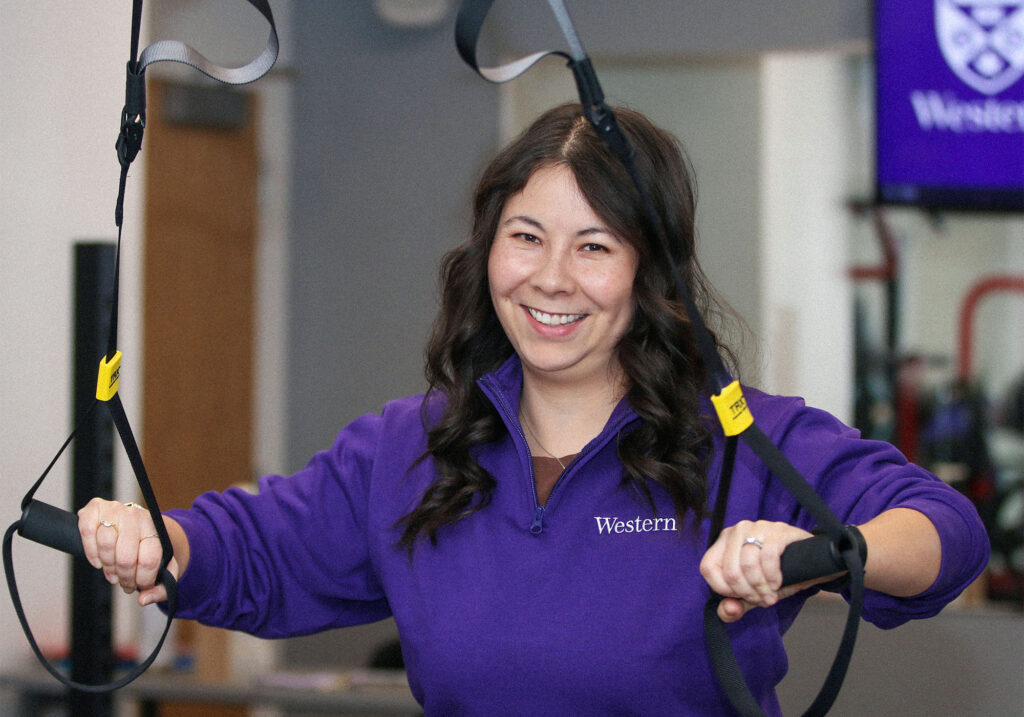What if medical science discovered a single treatment that’s safe and effective for more than 30 chronic diseases? Millions of lives would be transformed if conditions like heart disease, type 2 diabetes, cancer and even dementia could be prevented or their severity reduced.
They can be—all of them. The treatment is here, now. “Physical activity is the one thing we know absolutely everybody will benefit from, no matter what,” says Tina Ziebart, a Western physical therapy professor who studies ways to support healthy aging and independence into later life. But exercising doesn’t necessarily mean running or aerobics classes.
“Do whatever activity you enjoy. It’s never too late to start exercising,” says Western kinesiology professor Lindsay Nagamatsu, Canada Research Chair in Activity for Brain Health and Aging. “Even a moderate amount of consistent physical activity, at any age, can prolong quality of life and maintain your independence.”
Research from Nagamatsu and Ziebart reveals resistance training with weight is a critical part of aging well that improves not only our bodies, but our brains, too. Nagamatsu’s recent research on the link between weight training and cognition in older adults differs from many previous studies focused on aerobic exercise, such as running. Participants in her study exclusively lifted weights for six months. Nagamatsu’s team measured structural changes in their brains and functioning with neuroimaging and behavioral tests.
Resistance exercise multiple times a week can change how the brain processes information, leading to improved cognitive abilities.
Lindsay Nagamatsu
Canada Research Chair in Activity for Brain Health and Aging

“We found really promising results that resistance exercise multiple times a week can change how the brain processes information, leading to improved cognitive abilities, particularly those involving executive functions like planning, organizing and decision making,” Nagamatsu says. Weight-lifting is both treatment and preventative medicine, experts have found.
It offers hope to people living with mild cognitive impairment, a possible precursor to dementia, whose memory and thinking deficits don’t yet significantly interfere with everyday life. Nagamatsu’s work showed weight training can stabilize or even improve cognitive function in that population—preventing the progression to dementia and sometimes returning mental abilities all the way to normal levels. “We have a critical window of opportunity to intervene right now to stem the tide of dementia as our population ages,” Nagamatsu says.
The implications of more people doing weight-bearing exercise are immense. Not only could it allow older Canadians to live independently for longer, it could also keep thousands more out of hospital.
Physical activity, particularly weight-bearing exercise, helps increase bone density in youth and maintain it in adulthood—a critical intervention to help prevent osteoporosis or minimize the risk of fractures in people who have the degenerative disease. It’s a silent thief, depleting bone mass without symptoms until a fracture occurs. The condition can lead to disfigurement, loss of mobility and frailty.
“Osteoporosis is considered a child’s disease with adult consequences,” Ziebart says. “Both men and women who haven’t built up high bone mass while they’re young have a greater risk, because bone mineral density starts declining after age 30.”
One in five men and one in three women in Canada suffer a broken bone at least once due to osteoporosis, according to Osteoporosis Canada. Sue Murphy was one of them. She was an avid golfer who “morosely” contemplated quitting golf after suffering three fractures in five years.
An unexpected osteoporosis diagnosis in her late 50s was devastating enough, leaving her feeling confined by inescapable susceptibility to injury. “I had to rethink my every move. Even bending the wrong way to tie my shoes risked a fracture,” Murphy says.
I don’t feel frail now because I’ve learned what I can do safely while building strength. That is life-changing.
Sue Murphy
bone fitness class participant
The never-ending worry about breaking a bone with a simple misstep upended Murphy’s normal routine and sapped her enthusiasm for activities she loved. It also rattled her confidence. Her vulnerability and growing sense of frailty all changed when a physiotherapist referred her to the bone fitness class led by Ziebart at Reactive Physiotherapy in London, Ont. “The class is so empowering,” Murphy says. “Tina shows us the right way to move while we build up to lifting heavier weights.”
The class runs four times a year and is open to people diagnosed with osteoporosis or shown to be at risk in a bone density test. Ziebart first assesses people interested to ensure they can participate safely. The evidence-informed instruction teaches them how to exercise with proper form to maintain bone strength, improve balance and rehabilitate fractures. “The body mechanics I learned eventually became automatic—that gave me the confidence to resume everyday activities without constant fear of getting hurt,” Murphy says.
Ziebart says everyone—with or without osteoporosis—should prioritize strength and balance training, especially after age 50. “It is the prevention. Exercise is one of the best prescriptions. It’s universal,” Ziebart says, noting people in her class also see improvement with secondary health conditions such as diabetes, rheumatoid arthritis and high blood pressure after regular exercise. “I love helping people reclaim their vitality through activity.”
Making regular exercise a way of life helps Murphy persevere with optimism while living with osteoporosis. Better still was discovering she didn’t have to give up her favourite sport.
“Tina didn’t tell me I should never golf again. She showed me how to modify my swing to prevent a possible fracture,” Murphy says. “I don’t feel frail now because I’ve learned what I can do safely while building strength. That is life-changing.”